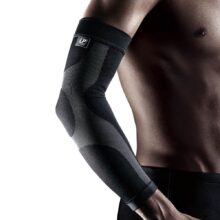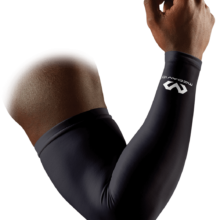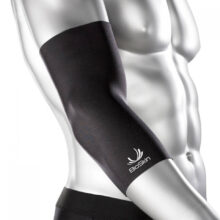Arm Power Sleeve
Out of Stock
Choose the LP Support Arm Power Sleeve to take your performance to new levels. The Power Band and Regulation Area will maintain ideal compression levels, minimize energy waste and improve kinetic capacity.

Pain in the biceps muscles at the front of the upper arm can affect anyone. However, it is more likely to happen to those with physically demanding jobs or recreational pastimes. It is also a greater risk for individuals who play sports.
In this article we will examine the most common reasons for bicep pain. We will also outline the most common treatments for each cause of this pain.
We emphasize that readers should be aware that the list of reasons for bicep pain that we present below is not exhaustive. If you are not sure of the reason for your pain, you should see a doctor for medical advice.
Sometimes, the biceps pain can be due to to a combination of two or more of the conditions mentioned below, rather than just one of them in isolation.
Bicep muscle strains can belong to any of three grades of severity:
Although these injuries are unpleasant, they are usually treatable at home and surgery is not required. Typically, a doctor will recommend that you:
If the strain is a grade 3 injury, surgery may be required to repair the damaged muscles or tendons.
This is another common cause of painful biceps. It is usually a result of overworking the muscle by increasing the intensity of exercise too rapidly.
The distinguishing feature of delayed onset muscle soreness (DOMS) is that it does not appear right away. Instead, it appears a few hours after (or even the day after) completing the activity.
DOMS tends to occur among athletes or physically active individuals. Consequently, it is a major object of study in the sports medicine field.
There are relatively few options for treatment. Pain relief medications such as tylenol (paracetamol) or Advil (ibuprofen) can help to ease discomfort. Massages have also been reported to have some success.
For additional information on treating and preventing DOMS, please read this article.
This is an overuse condition caused by irritation of the tendon connecting the bicep muscle to the shoulder. It occurs typically in people who perform tasks requiring repetitive overhead activity.This irritation leads to inflammation and then pain in the upper portion of the bicep muscle. The pain may be accompanied by tenderness and weakness just below the shoulder.
The bicep plays a major role in bending the arm at the elbow as well as supination (turning the palm of the hand to face upwards) of the forearm. As a result, this injury (and a bicep strain) can also reduce the shoulder range of motion.
The treatment plan for this injury is similar to that typically employed for bicep strains. The patient will need to rest and allow the tendon to recover naturally. Icing, painkiller medications like non-steroidal anti-inflammatory drugs and compressing the area are also parts of the standard treatment plan.
Other treatment options that can be tried 3-6 weeks after the acute injury include local anaesthetic and steroid injections. If, despite conservative treatments, symptoms persist beyond two months after the acute injury, an orthopaedic referral should be done.
For additional information on this injury, please consult this article
Bicep pain can also be a result of bruising (contusion) of the muscles. This can happen as a result of a blunt force that crushes the blood vessels inside the bicep. The blunt force can cause the blood to leak from the damaged vessels and be trapped inside the muscle. The result is muscle pain and tenderness.
This type of injury is analogous to a quadriceps contusion, described here.
Muscle bruising due to blunt force trauma can occur during involvement in contact sports or as a result of a fall.
Treating a bruised bicep (or other) muscle typically requires application of the same R.I.C.E. strategy described above for muscle strains.
Bicep pain can sometimes signal the onset of a heart attack. This is an event caused by a lack of sufficient blood flow to the heart, causing a portion of the heart muscle to die.
Besides bicep pain, those experiencing a heart attack will also have pain or tightness in the center or left side of the chest. They may also feel faint or lightheaded, have a cold sweat and shortness of breath. The pain may also be felt in the jaw, neck or back and there may also be nausea leading to vomiting.
The pain typically occurs in the centre or left side of the chest and sometimes radiates to the neck, jaw, back or arm. It would be unusual for a heart attack to cause pain in the arm alone without associated chest pain.
A heart attack is a life threatening event, and a medical emergency of the highest order. If you think your bicep pain may be a signal of one, call an ambulance (911) immediately or get someone to call for you. Remain calm until help arrives.

Out of Stock
Choose the LP Support Arm Power Sleeve to take your performance to new levels. The Power Band and Regulation Area will maintain ideal compression levels, minimize energy waste and improve kinetic capacity.


In Stock
The LP EmbioZ Arm Power Sleeve with Silicone incorporates a Power System along the elbow and upper arm muscles that increases the stability and proprioception of the elbow-wrist continuous movement. It will improve the accuracy of movements of your upper extremity and bring you enhanced performance with a reduced risk of injury. Try it and prepare to be amazed.

Typically Ships in 3-5 Business Days
The McDavid Compression Arm Sleeve / Single uses hDc Moisture Management Technology, a 6-thread flat-lock technology and 50+ UV skin protection for ultimate performance and comfort.


In Stock
The Bio Skin Standard Elbow Skin provides full elbow coverage and optimal compression for treatment of elbow pain caused from contusion, bursitis, and joint swelling. Constructed from Bio Skin’s patented thin, breathable, Ultima™ material, which keeps you cool and dry and quickly wicks moisture away from the skin